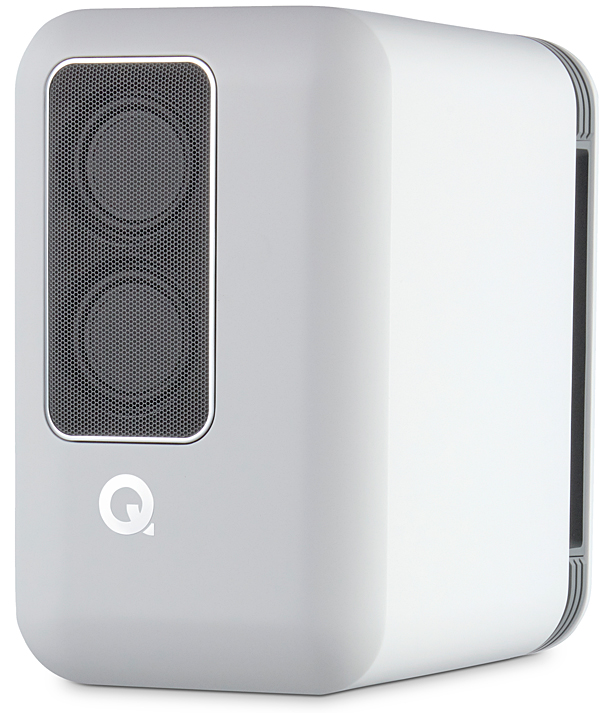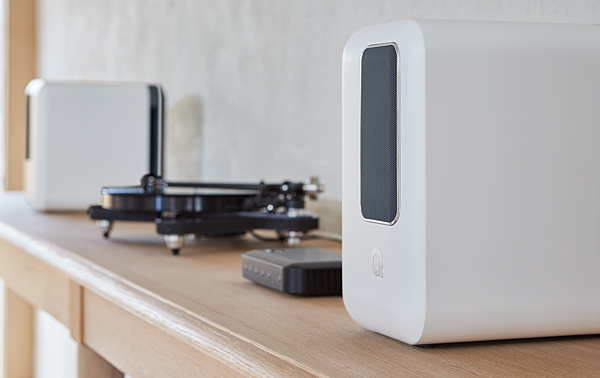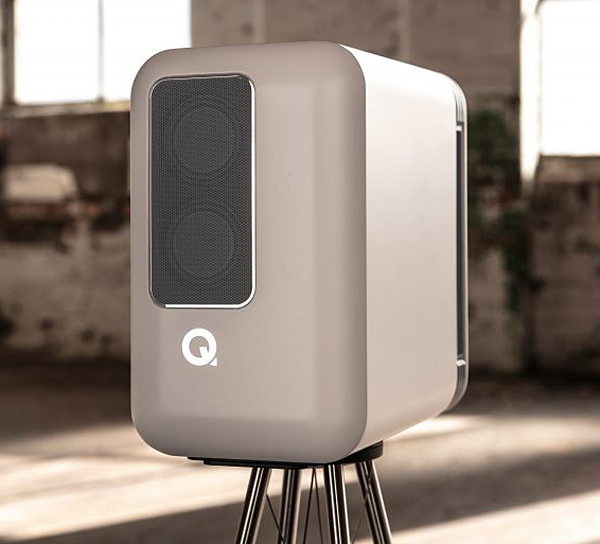These are fantastic value and I prefer them more than the KEF LS50 active. At the sale prices, they are awesome investment for a long time of enjoyment.
Q Acoustics Q Active 200 Loudspeaker Review Page 2
Performance
In tonal-balance terms, the Q Active 200 system proved impressively neutral and accurate. They almost perfectly averaged my two references (ancient-but-accurate Energy Veritas 2.8s, and my long-term active monitors). This means that voices were entirely free of colorations from resonances or crossover errors—remember, there's no crossover in the midrange/vocal octaves here— and the warmth/bite balance and articulation of elements like massed strings and brass were perfectly natural and, in the best sense, unobtrusive.
 The one departure from this near perfection (if departure it is), was in the top "sparkle" octaves. Treble was amply present all the way up to the top, but the Q Active 200s were slightly less prominent, or perhaps "lively" is a better term, than my references. Consequently, on the Fleetwood Mac classic "Dreams" (24-bit/96kHz FLAC, Qobuz), the hi-hat "tick- tick-tick" that runs relentlessly throughout the song was, while only barely less present, audibly less "ticky," with just a shade less leading edge. (This may or may not be more or less "accurate." While long- standing research shows that a 1-to-2dB-per-octave down-tilt in top-octaves response is "best" for speakers in typical listening rooms, a great majority of audiophile designs eschew this, presumably to favor the "air" and "sparkle" that help sell speakers.)
The one departure from this near perfection (if departure it is), was in the top "sparkle" octaves. Treble was amply present all the way up to the top, but the Q Active 200s were slightly less prominent, or perhaps "lively" is a better term, than my references. Consequently, on the Fleetwood Mac classic "Dreams" (24-bit/96kHz FLAC, Qobuz), the hi-hat "tick- tick-tick" that runs relentlessly throughout the song was, while only barely less present, audibly less "ticky," with just a shade less leading edge. (This may or may not be more or less "accurate." While long- standing research shows that a 1-to-2dB-per-octave down-tilt in top-octaves response is "best" for speakers in typical listening rooms, a great majority of audiophile designs eschew this, presumably to favor the "air" and "sparkle" that help sell speakers.)
Otherwise, the soundstage presented by the Q Active 200s was deep, spacious, and distinctly more diffuse than my refs. On a state-of-the-studio track like Rickie Lee Jones' characteristically odd reading of the Tim Hardin classic "Reason to Believe" from The Devil You Know (16/44.1kHz FLAC, Tidal), either of my long-term speakers will throw out a tightly localized image of musicians in space: fiddle to the left, voice in the middle, dobro to the right. The Q Active 200s did the same, but, presumably due to the BMR drivers' wide, half-space radiation, with a larger, deeper and, perhaps, more vague localization. This is an observation, not a criticism, since I find that the typical "hi-fi soundstage" pinpoint localization is in fact less natural relative to real-world acoustics as experienced in clubs and halls.

Another listening note has to do with ambience, though this one is tricky to express. Many, perhaps most, studio recordings, old and new, depend on added reverberation (whether digital or analog) for enhanced spaciousness. A good example is the Van Morrison classic "And it Stoned Me" from his seminal Moondance album (24/96 FLAC, Qobuz). On my references, I hear the reverb ambience as a sort of "layer" of space behind the musicians, which sounds to me like a classic 1970's-era studio plate reverb. Via the Q Active 200s, the character of the reverb was largely unchanged, but it was more "all-around" the sound sources: better integrated, and slightly warmer-sounding. Precisely what causes this I can't say, but presume that, again, it has something to do with the unique radiation pattern of the BMR drivers.
To the same point, the Q Active 200s really do keep a strong stereo effect well off- axis—just as the company's marketing materials claim. I could sit fully 30 degrees off-center and still hear generous spread to the "off-side" speaker; it was not full-width stereo, of course, but most conventional direct-radiators collapse almost entirely into the near-side speaker under the same conditions. I also tried the Q A200s in both my initial innie and outie setups, with the offset BMR mid/high "windows" first to the insides, then to the outsides. The difference was extremely subtle but, in my room, where the side walls were about 7 feet distant, innie promoted slightly tighter imaging.
At the low end, the Q Active 200s have ample output to about 45Hz or so—plenty for most music genres—but fall off rapidly below that point. The combination of their three low- equalization room-boundary settings (Corner, On-wall, and In-room) and the option to run in sealed (foam bungs-in) or vented (bungs out) alignment, effectively yields six different results— plenty to fine-tune bass to most any room or taste. In my setup, where their baffles were about four feet out from the front wall and well distanced from the corners, I found the On-wall setting, with bungs in, to be optimal, while the in-room setting was too rich either way, bung-wise. And though Corner with bungs out was nice, and perhaps a bit punchier, I clearly preferred the first option. Overall, the bass balance of the Q Active 200s is very slightly rich, same as with most small two-way speakers, since designers usually balance them to compensate for their declining deeper bass. But

in this case the speaker's boundary-comp options give you the tools to substantially shape the bass balance to taste. Even in my spacious studio, the Q Active 200 system had plenty of output to make orchestral music convincing, and rock'n'roll to sound suitably kicking. That said, this is not a system for headbangers, as the speakers will not play infinitely loudly with full quality. Over the last 6dB or so of available range (all of it louder than I would ever listen recreationally), the midrange progressively became a little "hard," and strong bass began to lag.
The Other Stuff
The Q Acoustics system's user interface is, effectively, that of the app or source you are using to stream to it. There is a Q Acoustics app, but this—in its iOS iteration, at least—is confined to basic setup options, input selection, and volume control, with no integrated streaming of outside services. The streaming source I used, Roon, for my own ripped files plus Qobuz and Tidal pass-through, worked flawlessly. Team Q do supply a basic remote with volume, mute, play/ pause/skip (these worked on my streaming sources), and direct input-select buttons for Net, Blu(tooth), Ana(log), and Opt(ical) sources. Annoyingly, any time there was a power interruption to the hub, this lost remote "pairing," and the only way I could restore it was to perform a full factory reset of both speakers and hub.
In the name of thoroughness, I also tried CD playback from a disc-player via both optical and analog stereo connections, and even spun a couple of LPs after switching the hub's rear-panel input-select toggle. A frequent user of both line-level and phono sources will surely tire of this cable-swap/switch routine, necessitated by the hub's single, shared RCA input. And I also predict that the same user will eventually be in for a nasty, 30dB surprise level boost when switching back over to the line source but forgetting to flip the toggle from Phono to Line. (Ask me how I know.) Otherwise, in all cases the system sounded fine.

I mostly auditioned the Q Active 200s on my own stands, but for an earlier session used Q Acoustics' dedicated Q FS75 stands (a $499 option—gulp!), a gorgeous set of stressed-cable quadra-pods that the firm claims to minimize resonances from speaker to floor or the reverse. I can't say I heard any difference—obviously, it's impossible to compare speaker stands meaningfully—but they sure look purty. If the Q Active 200 speakers' considerable visual appeal is a factor, you're also going to want these, since the combined effect is of something from the Star Wars universe
Conclusion
To sum up, Q Acoustics' Q Active 200 system is a fascinatingly different design, and I enjoyed my sojourn with it. It's dead-perfect for the listener who might otherwise buy a brand-S or brand-B (or a Google or Amazon or Apple) all-in-one, but desires, and is willing to pay for, something much better, which this system most decidedly is. Could you, for the same money, get a bit better performance from conventionally wired passive speakers? Certainly, but you will sacrifice the integration, simplicity, and, of course, wireless-ness. And you'll need to spend significant bucks for sources and for amplifiers as well. For anyone who finds the Q Active 200's just- add-music concept alluring, I strongly recommend pursuing a serious audition.
- Log in or register to post comments


If only the stands weren't so ugly!

If you want hassle-free parking in Greece, I recommend https://aktis.rent/en/blog/rules-of-parking-cars-in-greece . Here you can find full information about paid parking zones, as well as handy maps and tips on how to pay via machines or mobile apps. This site helped me quickly understand the local rules and avoid fines. A great resource for tourists and drivers!






























































